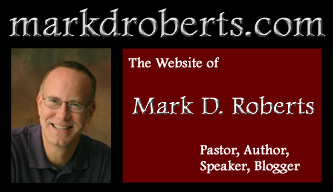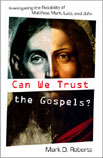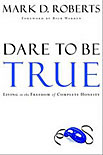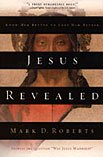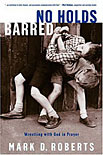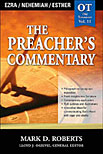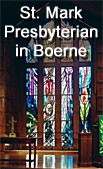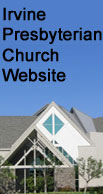My blog has moved! http://www.patheos.com/blogs/markdroberts/
|
 |
Twitter Feed for My Recent Blog Posts and Other Tweets |
My blog has moved! http://www.patheos.com/blogs/markdroberts/
|
Tod Bolsinger Offers Wise Insights on Pastors and Their Souls
By Mark D. Roberts | Friday, April 9, 2010
A couple of days ago I posted excerpts from a recent letter of John Piper to his congregation. In this letter, Piper explains in strikingly honest terms that he is taking an eight-month leave of absence from his pastoral duties in order to focus on his marriage and his soul.
Today, on his blog, It Takes a Church, Tod Bolsinger offers some reflections in response to Piper’s letter. Tod, the Senior Pastor of San Clemente Presbyterian Church in Southern California, has some very wise things to say about pastors and their souls. I’d strongly encourage you to read the extended excerpt below, even if you are not a pastor.
Here’s what Tod writes:
I once was part of a leadership group with renowned CEO Max DePree. Someone made the comment about how hard we pastors work and someone else chimed in that pastors work harder than anyone. Max wisely and calmly chided us, saying that from his experience pastors don’t work harder than any other executive or mid-level manager in most companies he knows. I wholeheartedly agree. I don’t travel nearly as much as most of the men my age in my congregation. And while I work hard, I also get lots of support to balance family and personal time with work time. (I am even taking a few days off this week to recuperate from Holy Week.)
However there are two ways, that both collude very negatively and demonstrate how pastoral work is at least a bit more COMPLICATED than other professions. And it is that complexity that is potentially very dangerous to souls, relationships and, yes, ministries of pastors and other Christian leaders.
1. We work in what Ed Friedman calls “an emotional field”. That is that our work, by it’s very nature, is work that demands that we constantly negotiate and monitor our own emotional issues while at the same time navigating the emotions and anxieties of other people and the church system. We not only preach, teach, lead, administrate, counsel and consult, we do it while also attending to the emotional health of the church system, tending to (mostly unspoken) projections and expectations of a community that is by nature filled with confusing boundaries. The church is a “family” and a “business” at the same time. People want us to be both “professional” and “personal”. We get criticized for not knowing everything there is to know about the mystery of God and not knowing every person’s name in our congregation when we run into them at the grocery store. Our congregation is both our “customer” and our “client” and our “partners” and our “bosses” all at the same time. Again, we don’t work harder. It’s just really complex and emotionally really demanding.
2. Ministers are very prone to confuse our “self” with our “roles”. In our “roles” we are admitted into the holy ground of people’s personal lives and literally into every setting in the church life. (And in the church itself: I have a coveted “#1 key” that can open every door in our church. An apt symbol for the role of a pastor.) We are often asked to pray at OTHER people’s family gatherings, we get welcomed into hospital rooms that even family members can’t go in. People trust us with family secrets. I can walk into any meeting, any classroom, any conversation on the patio at our church and they will literally stop what they are doing to welcome me and listen to whatever I want to say. But that is because I am the “PASTOR”. (”Tod” can’t do any of that. Because when I try that at home, my 13 year old daughter says, “Daddy, you’re interrupting!” ) And the respect and affirmation we get as pastors is heady stuff and often in great contrast to the “normal” lives we live outside the pulpit and away from the congregation. As a pastor, when I preach a sermon, people literally tell me they “LOVE me.” And I think, at that moment, they really mean it. When God works in people’s lives, they genuinely feel something of love toward the messenger. And since most of us who go into ministry do so as “wounded healers” who are working out their own brokenness, it is really tempting for ministers to work out their personal foibles in the church setting and neglect their emotional, relational and spiritual lives. It is very tempting to believe that because others are being saved, sanctified and comforted through you, that you MUST really be as secure, holy and solid as WISH you were. Most Christian leaders problems come from confusing the “role” that God gives us and equips us to play with the “self” that is always in need of grace, community, and truth to be whole.
We pastors must indeed bring our real “self” to our roles, but we must keep clear that we are NOT our roles. We are children of God in need of discipline by our heavenly father, we are spouses and parents and siblings and friends. We are saints in need of sanctification and sinners in need of forgiveness. We may pray eloquently and preach passionately, but we also snore and swear and have hurt feelings and very humble foibles and fears. If we only play the role all the time, not only do our families and relationships suffer, our souls will die, too.
In the famous story, Narcissus is cursed for being cruel to another. The curse is that he will fall hopelessly and helplessly in love with the next face he sees. He sees his own face in a reflection in a lake and then can’t take his eyes off of his own reflection, so he sits by the lake pining in sadness until he dies. We tend to think of narcissists as ego-maniacs who “love themselves”. But as the best psychology will tell us, narcissism is a wound that comes from not getting enough love and care for our “real” selves. We narcissists (and pastors are in the same category with actors, politicians and business executives here) are those who have learned to get affirmation for our “image” that we can’t seem to get for our “selves.” We must never forget that in the myth, Narcissus, dies of starvation. He can’t pull away from attending to the image in the lake to feed his genuinely hungry self.
Thanks, Tod, for these wise words.
Topics: Church Life | 2 Comments »
Now That’s What I Call a Mascot!
By Mark D. Roberts | Thursday, April 8, 2010
Today as I was driving to work I saw a bus from St. Mary’s University. This highly-regarded university, situated in San Antonio, was founded in 1852 and is the oldest Catholic university in the Southwest.
I’ve been familiar with St. Mary’s ever since I moved to Texas, near San Antonio, two and a half years ago. But, until today, I did not know the name of the St. Mary’s mascot. They are . . . the Rattlers. That’s right, the St. Mary’s Rattlers.
 Now I don’t know how that strikes you, but it seems rather ironic that a university named after the mother of Jesus has a rattlesnake as its emblem. Not an angel or a manger, but a fang-bearing rattlesnake.
Now I don’t know how that strikes you, but it seems rather ironic that a university named after the mother of Jesus has a rattlesnake as its emblem. Not an angel or a manger, but a fang-bearing rattlesnake.
I wondered how St. Mary’s came to be called the Rattlers, so did a bit of research, and found an explanatory page on the St. Mary’s website. In summary, it explains that the Rattler mascot was named by Brother Charles Kinsky in 1926 after a spirit committee decided to borrow the name of the school newspaper, The Rattler. Legend holds that the name was based on the fact that the school’s football field had to be cleared of rattlesnakes on a regular basis. This seems not to be the case. I can believe, however, that some real rattlers figured into the story somewhere.
Now what I find most interesting here, apart from the odd connection of the Virgin Mary and rattlesnakes, is the theological irony. There is a long, long tradition that associates Mary with snakes. It is based on a passage in Genesis 3, where God cursed the serpent who had tempted Adam and Even to sin:
“Because you have done this,
cursed are you among all animals
and among all wild creatures;
upon your belly you shall go,
and dust you shall eat
all the days of your life.
I will put enmity between you and the woman,
and between your offspring and hers;
he will strike your head,
and you will strike his heel.” (3:14-15)
From the early days of the church, Christian theologians interpreted this passage as referring to Mary, whose offspring, Jesus, would “strike the head” of the serpent. Mary and snakes are enemies from almost the dawn of time. But not at St. Mary’s University, apparently.
At least the Rattlers mascot conveys something strong and scary, just the sort of thing you’d want for your athletic teams, unless of course you go to the University of California Santa Cruz, where your mascot is the Banana Slug. No kidding!
Topics: Fun | 1 Comment »
A Christian Leader Opens His Heart and Sets an Example for Us
By Mark D. Roberts | Wednesday, April 7, 2010
I learned today that John Piper, Pastor for Preaching and Vision of Bethlehem Baptist Church, prolific author, and one of our nation’s most influential Christian leaders, is taking an eight-month leave from his work as a pastor, writer, and speaker.
This, in and of itself, is a bit surprising, given Piper’s usual volume of productivity, which is vast. But even more surprising is his explanation for this leave. Though he keeps private that which ought to be private, Piper opens his heart and life in a way that few people do, especially highly-regarded Christian leaders.
Here are some excerpts from the letter Piper posted on the church website:
I asked the elders to consider this leave because of a growing sense that my soul, my marriage, my family, and my ministry-pattern need a reality check from the Holy Spirit.
I see several species of pride in my soul that, while they may not rise to the level of disqualifying me for ministry, grieve me, and have taken a toll on my relationship with Noël and others who are dear to me. How do I apologize to you, not for a specific deed, but for ongoing character flaws, and their effects on everybody?
Noël and I are rock solid in our commitment to each other, and there is no whiff of unfaithfulness on either side. But, as I told the elders, “rock solid” is not always an emotionally satisfying metaphor, especially to a woman. A rock is not the best image of a woman’s tender companion. In other words, the precious garden of my home needs tending.
The other way that our marriage is not an island is that its strengths and defects have consequences for others. No one in the orbit of our family and friends remains unaffected by our flaws. My prayer is that this leave will prove to be healing from the inside of my soul, through Noël’s heart, and out to our children and their families, and beyond to anyone who may have been hurt by my failures.
In 30 years, I have never let go of the passion for public productivity. In this leave, I intend to let go of all of it. No book-writing. No sermon preparation or preaching. No blogging. No Twitter. No articles. No reports. No papers. And no speaking engagements.
Personally, I view these months as a kind of relaunch of what I hope will be the most humble, happy, fruitful five years of our 35 years at Bethlehem and 46 years of marriage. Would you pray with me to that end?
I have no need to “read between the lines” and figure out what was “really going on.” I trust John Piper to be honest and believe that he has been extraordinarily open here about his own shortcomings. Thus, I don’t believe there’s any hidden story to be found here.
But I do believe there are some valuable lessons to be learned, for all of us, but especially for those of us who are Christian leaders (pastors, elders, etc.). Here are some of those lessons:
Don’t we all need times when we step back and get a “reality check” from the Holy Spirit? I know I do. Yet it’s easy not to step back and listen to the Lord.
Yes, being “rock solid” in one’s marriage is essential, but not enough. Piper speaks the truth when he says that “’rock solid’ is not always an emotionally satisfying metaphor, especially to a woman. A rock is not the best image of a woman’s tender companion. In other words, the precious garden of my home needs tending.” As one who tends toward the rocky side of things, this is a powerful and pointed word for me. I think many, many pastors, in particular, should reflect upon what Piper is saying here about the quality of relationship in a marriage. (Thank you, John, for your openness about this!)
I admire Piper’s gutsy choice to step back from his work – indeed, his godly work – in order to focus on his marriage and his soul. This example both challenges and encourages me. Even if I’m not in a position to take (or to need) an eight-month sabbatical, I can certainly make choices to prioritize my relationships with my wife and children.
Actually, I’m going to make one of those choices now, and stop writing so that I can walk the dog with my wife. I will be praying for John and Noël Piper, and for so many others of us who wrestle with challenges similar to theirs. May God give us the grace to be honest with our Lord, with ourselves, and with our Christian community.
Topics: Christian Life | 5 Comments »
A Surprising Easter Tradition
By Mark D. Roberts | Tuesday, April 6, 2010
 Most of our traditional Easter practices happen on Easter Sunday: going to church with family, a sunrise service, a special dinner, wearing fancy spring dresses, hunting for eggs, and so forth. In church, we sing music reserved for Easter, hymns such as “Christ the Lord Is Risen Today.” And in many of our churches, we greet one another with the classic resurrection greeting: “Christ is risen! He is risen, indeed!”
Most of our traditional Easter practices happen on Easter Sunday: going to church with family, a sunrise service, a special dinner, wearing fancy spring dresses, hunting for eggs, and so forth. In church, we sing music reserved for Easter, hymns such as “Christ the Lord Is Risen Today.” And in many of our churches, we greet one another with the classic resurrection greeting: “Christ is risen! He is risen, indeed!”
I love these traditions. (Oh, for the record, I didn’t wear Easter dresses. But I love seeing my daughter in hers! Note the photo to the right.) It’s convenient that I am a fan of Easter traditions because, when I was the Senior Pastor of Irvine Presbyterian Church, I participated in four services each Easter morning, starting with a sunrise service at 6:00 a.m. As you might guess, one of my Easter traditions included taking a nap in the afternoon!
In the last few years, I added one more tradition to those I have cherished for years. This one might be surprising to you. It might even seem a little odd. Here it is: During the season of Easter, I listen to Handel’s Messiah.
Now before you think I’m confusing Easter and Christmas, let me explain. I know that we tend to associate the Messiah with Christmas, and for good reason. The first part of this musical masterpiece does celebrate the birth of Jesus: “For unto us a child is born . . .” Yet if you listen carefully to the whole Messiah, you may be surprised to learn that the birth of Jesus comes about 25% into the piece. The death of Jesus comes near the halfway point. The final 40% of the Messiah celebrates the resurrection of Jesus and its implications. This means, in terms of number of minutes, the Messiah is more of an Easter piece than a Christmas piece.
But what about the beloved “Hallelujah Chorus”? Isn’t it found in the Christmas section? Not in Handel’s original composition. It comes at the end of Part II as a celebration of the resurrection and the beginning of Christ’s reign as “King of kings and Lord of lords.”
The fact that George Frideric Handel (1685-1759) intended the Messiah as an Easter celebration is evident, not only in the libretto (the words) of the piece, but also in the circumstances of its debut. Handel’s masterpiece was first performed in Dublin on April 13, 1742, 19 days after Easter. This is surely no accident. If he had intended the Messiah for Christmas, surely he would not have planned for an Eastertide grand opening.
Let me be clear that I don’t have a problem with anyone listening to the Messiah during the season of Advent and Christmas, I do this very thing every year, quite happily, I might add. Moreover, one of the highlights of my musical life was joining the choir of Irvine Presbyterian Church as we sang the Christmas portion of the Messiah (plus the Hallelujah Chorus) along with an orchestra. (You can hear a short clip of our choir by clicking here. It’s a QuickTime file.)
But let me encourage you to join me in what might be a new Easter tradition for you. Listen to Handel’s Messiah all the way through. It takes a little more than two hours, and is well worth the time. You might also want to study the libretto, noting the brilliant use of Scripture. But then just let the music lead you to a joyful celebration of salvation in Jesus, beginning with his birth, continuing through his life, death, and resurrection.
I will close by quoting the last words of the Messiah, other than the three minute series of “Amens.”
“Worthy is the Lamb that was slain, and hath redeemed us to God by his blood, to receive power, and riches, and wisdom, and strength, and honour, and glory, and blessing. Blessing and honour, glory and power be unto him that sitteth upon the throne, and unto the Lamb, for ever and ever.” (based on Revelation 5:12-13)
P.S. If you’d like a more detailed study of Handel’s Messiah and its Easter focus, you might check out a series I wrote a couple of years ago: Handel’s Messiah and Easter.
Topics: Easter | 2 Comments »
Five Reasons to Love Spring
By Mark D. Roberts | Monday, April 5, 2010
In my adult years, I have come to enjoy flowers. When I lived in Irvine, I would always plant flowers at about this time of year: Impatiens, Begonias, etc. Things are different now. My yard in Texas is considerably more natural and unkempt. And flower gardens tend to become a buffet for the deer. So I’m not much into planting flowers.
But the good news is that they just come up wild, all over my yard. We’ve had a lot of rain this year, so the wildflowers are having a field day (so to speak). This weekend I counted over a dozen different varieties of flowers. I thought I’d share five examples with you, five wonderful reasons to love Spring.

Fringed Puccoon

Thistle

Stemless Evening Primrose

Agarita (watch out for those leaves!)

Bluebonnet
God’s artistry continues to amaze me.
Topics: Nature | 3 Comments »
God’s Resurrection Power for Us!
By Mark D. Roberts | Sunday, April 4, 2010
I also pray that you will understand the incredible greatness of God’s power for us who believe him. This is the same mighty power that raised Christ from the dead and seated him in the place of honor at God’s right hand in the heavenly realms.
Christ is risen! He is risen, indeed!
Christians confess that Christ is risen, not only in the hearts of the faithful, and not merely as some nice religious image, but truly and physically. On Easter morning, the tomb of Jesus was empty. The bondage of death was broken, both for him and for us, by the power of his resurrection.
 We can only begin to understand the divine power that raised Jesus from the dead. The more we think of it, the more we are astounded. Only God, who created all things in the first place, would have the power to give life to one who had died. (Photo: A painting of the resurrection of Jesus by Matthias Grünewald, as a part of his famous Isenheim Altarpiece, c. 1515)
We can only begin to understand the divine power that raised Jesus from the dead. The more we think of it, the more we are astounded. Only God, who created all things in the first place, would have the power to give life to one who had died. (Photo: A painting of the resurrection of Jesus by Matthias Grünewald, as a part of his famous Isenheim Altarpiece, c. 1515)
Ephesians adds to our astonishment. The “mighty power that raised Christ from the dead” is in fact “God’s power for us who believe him” (vv. 19-20). The Greek phrase translated here as “for us” (eis hemas) could mean “for our sake.” But, most literally, it means “into us” and is probably a stylistic variation of “in us.” This translation is supported in Ephesians 3:20: “Now all glory to God, who is able, through his mighty power at work within us [en hemin], to accomplish infinitely more than we might ask or think.”
Just think of it! The same power that shattered the prison of death sets us free from all that binds us. The very Spirit of God lives in us to empower us for the ministry of the kingdom of God. Resurrection power is for us, in us, and at work through us.
Thus we live as Easter Christians, not simply with gratitude for our salvation, and not merely with hope for the future. We live as God’s ministers, filled with his resurrection power, extending his kingdom into every facet of our lives. We are Easter people at home and at church, at work, and at play.
Christ is risen! He is risen, indeed!
QUESTIONS FOR REFLECTION: How have you experienced the power of God at work in your life? Where do you need God’s power today? tomorrow?
PRAYER: Gracious God, how we praise you for your power made known in the resurrection. Death could not defeat you. Rather, the death of Jesus set the stage for an extraordinary display of your power. Christ is risen! You have won the battle. Alleluia!
Yet the power of the resurrection is not merely something we celebrate joyfully, but also something we can experience daily. Your power is for us, helping us, guiding us, setting us free. Your power is in us, healing us, renewing us, and gifting us for ministry, so that we might serve you in the church and in the world.
Even as we celebrate the power of your resurrection on this Easter Sunday, may we live by that power today and each day of our lives. And may your church be renewed by this power, so that we might live each day as a demonstration of your resurrection.
To you be all the glory. Alleluia! Amen.
Topics: Holy Week & Easter | 1 Comment »
The Seven Last Words of Christ for Holy Week: The Seventh Word
By Mark D. Roberts | Saturday, April 3, 2010
“Father, I entrust my spirit into your hands.”
Two of the last seven “words” of Jesus were quotations from the Psalms. Earlier Jesus had used Psalm 22, “My God, my God, why have you abandoned me?” to express his anguish. Later he borrowed from Psalm 31, which comes to us from Luke as “Father, I entrust my spirit into your hands.”
In his citation of Psalm 31:5, Jesus was putting his post-mortem future in the hands of his Heavenly Father. It was as if he was saying, “Whatever happens to me after I die is your responsibility, Father.”
But when we look carefully at the Psalm Jesus quoted, we see more. Psalm 31 begins with a cry for divine help:
O LORD, I have come to you for protection;
don’t let me be disgraced.
Save me, for you do what is right. (v. 1)
But the Psalm it mixes asking for God’s deliverance with a confession of God’s strength and faithfulness:
I entrust my spirit into your hand.
Rescue me, LORD, for you are a faithful God. (v. 5)
By the end, Psalm 31 offers praise of God’s salvation:
Praise the LORD,
for he has shown me the wonders of his unfailing love.
He kept me safe when my city was under attack. (v. 21)
By quoting a portion of Psalm 31, therefore, Jesus not only entrusted his future to his Father, but also implied that he would be delivered and exonerated. No, God did not deliver him from death by crucifixion, because this was an essential element in the divine plan. But beyond Jesus’ horrific death lay something marvelous. “I entrust my spirit into your hands,” he says, pointing back to the familiar suffering of David in Psalm 31 and forward to the resurrection. These words prepare us for what is coming on Sunday morning.
QUESTIONS FOR REFLECTION: Have you put your life and, indeed, your life beyond this life, in God’s hands? How do you experience God’s salvation through Christ in your life today?
PRAYER: Gracious Lord, even as you once entrusted your spirit into the hands of the Father, so I give my life to you. I trust you and you alone to be my Savior. I submit to your sovereignty over my life and seek to live for your glory alone. Here I am, Lord, available to you, both now and in the future.
How good it is to know, dear Lord, that the cross was not the end for you. As you entrusted your spirit into the Father’s hands, you did so in anticipation of what was to come. So we reflect upon your death, not in despair, but in hope. With Good Friday behind us, Easter Sunday is on the horizon. Amen.
_________________________________________________
 Would you like to receive a Daily Reflection like this one in your email inbox each morning?
Would you like to receive a Daily Reflection like this one in your email inbox each morning?
Here’s how . . . .
This devotional comes from The High Calling of Our Daily Work (www.thehighcalling.org), a wonderful website about work and God. You can read my Daily Reflections there, or sign up to have them sent to your email inbox each day. This website contains lots of encouragement for people who are trying to live out their faith in the workplace.
Topics: Holy Week & Easter | No Comments »
The Seven Last Words of Christ for Holy Week: The Sixth Word
By Mark D. Roberts | Friday, April 2, 2010
“It is finished.”
I never saw a more difficult film to watch than Mel Gibson’s The Passion of the Christ. For most of that movie, I wanted to avert my eyes. It was horrible to watch even a cinematic version of a crucifixion. And it was beyond comprehension to think that this actually happened to somebody, and not just anybody, but my Lord and Savior. I had studied the crucifixion before and knew in my head what Jesus experienced. But seeing a visual presentation of his suffering was almost more than I could bear. When The Passion of the Christ was over, I felt palpable relief. Thank goodness it was finished.
When Jesus said, “It is finished,” surely he was expressing relief that his suffering was over. “It is finished” meant, in part, “This is finally over!” But the Greek verb translated as “It is finished” (tetelestai) means more than just this. Eugene Peterson captures the full sense of the verb in The Message: “It’s done . . . complete.” Jesus had accomplished his mission. He had announced and inaugurated the kingdom of God. He had revealed the love and grace of God. And he had embodied that love and grace by dying for the sin of the world, thus opening up the way for all to live under the reign of God.
Because Jesus finished his work of salvation, you and I don’t need to add to it. In fact, we can’t. He accomplished what we never could, taking our sin upon himself and giving us his life in return. Jesus finished that for which he had been sent, and we are the beneficiaries of his unique effort. Because of what he finished, you and I are never “finished.” We have hope for this life and for the next. We know that nothing can separate us from God’s love. One day what God has begun in us will also be finished, by his grace. Until that day, we live in the confidence of Jesus’ cry of victory: “It is finished!”
QUESTIONS FOR REFLECTION: Do you live as if Jesus finished the work of salvation? Do you have confidence that God will finish that which he has begun in you?
PRAYER: How can I ever find words to express my gratitude to you, Lord Jesus? You did it. You finished that for which you had been sent, faithful in life, faithful in death. You accomplished that which no other person could do, taking the sin of the world upon your sinless shoulders . . . taking my sin so that I might receive your forgiveness and new life.
All praise be to you, gracious Lord, for finishing the work of salvation. All praise be to you, dear Jesus, for saving me! Amen.
_________________________________________________
 Would you like to receive a Daily Reflection like this one in your email inbox each morning?
Would you like to receive a Daily Reflection like this one in your email inbox each morning?
Here’s how . . . .
This devotional comes from The High Calling of Our Daily Work (www.thehighcalling.org), a wonderful website about work and God. You can read my Daily Reflections there, or sign up to have them sent to your email inbox each day. This website contains lots of encouragement for people who are trying to live out their faith in the workplace.
Topics: Holy Week & Easter | 3 Comments »
What Kind of Theological Renewal Does the Evangelical Church Need Most?
By Mark D. Roberts | Thursday, April 1, 2010
The Evangelical Portal of the Patheos website is featuring a new conversation called the Cross Investigations Group. Here’s how Patheos describes this endeavor:
The Cross Investigations series encourages pastors, professors, authors, and bloggers to explore questions of import to the church in a coherent and cooperative manner. Every two weeks, a question will be posed to the group, and individual responses will be featured as they arrive at the Cross and Culture blog on the Evangelical Portal. One week after the question is sent, the answers will be gathered together into a single article. We hope that reflecting together will stimulate thought, focus conversation, and ultimately prove more edifying to online readers and to the church more generally.
The first question posed for Cross Investigations asked commentators to weigh in on the king of theological renewal that is most needed among evangelicals today. Specifically, here’s the question:
“Evangelical churches are showing renewed interest in theology and theological training. If the church in America could recover one area of doctrine or theological tradition (i.e., ecclesiology, pneumatology, doctrine of God), what should it be?”
If you were going to answer this question, what would you say?
I was asked to participate in the Cross Investigations Group, which includes a number of top thinkers and leaders among evangelicalism. So if you visit the Patheos website, you can find my answer to this week’s question. But I would encourage you to read all the answers, and to listen to the video answer provided by Andy Crouch. You’ll find a variety of answers to the question, and some significant overlaps and connections as well. In fact, Christian theology is so interconnected that its impossible to single out any one particular doctrine from others. You can’t, for example, talk about the church (ecclesiology) without also dealing with history and the end times (eschatology), salvation (soteriology), and the doctrine of God (theology proper).
I hope, by the way, that you’ll become a regular visitor to the Patheos site. I continue to be impressed with the quality of the conversation there about matters of faith and religious practice.
P.S. I have not fogotten that I stopped my conversation about Redeemer Presbyterian Church in NYC midstream. I’ll pick that up after Easter.
Topics: Theology, Christian Life | No Comments »
The Trauma of Changing Church Music: An Ironic Story
By Mark D. Roberts | Wednesday, March 31, 2010
As I mentioned a couple of posts ago, many people are traumatized by the changing of music in church. I am one of those people. I must confess that I am bugged when I’m singing a familiar hymn, one I memorized in my youth, and all of a sudden everybody else is singing different lyrics. I look down at the hymnal – or up at the screen – and realize that the words i know are not what we’re supposed to sing. I feel awkward and embarrassed.
More often than not, however, the problem I face in worship is not altered hymns and songs, but altogether new ones. In my role at Laity Lodge, I get around to quite a few different churches. For the most part, I know the hymns, usually by heart. But often I’ll have to sing three or four praise songs that are unfamiliar to me . . . and I know most of the CCLI top 100.
As worshiper, I know how difficult it can be sing to hymns and songs I don’t know. And I know how much I’d rather not sing music that is not in a genre I appreciate. As a pastor, I know how tricky it is to introduce new music, and how much changing familiar hymns and songs is a precarious and delicate operation.
What I’ve just described is true for virtually every church I’ve ever attended. It’s not just traditional churches that struggle with unfamiliar songs. Even new churches, churches on the “cutting edge,” quickly get settled in their patterns. If their leaders dare to change those familiar patters, they inevitably confront the ire of some worshipers.
 I learned about this in 1992, shortly after I became the Senior Pastor of Irvine Presbyterian Church in Southern California. One Sunday afternoon, my wife and I decided to attend the Anaheim Vineyard. That’s where John Wimber was the pastor. The Vineyard, as you may know, had been extremely influential in the praise and worship music movement. Many of the most popular worship songs of that time had been written by Vineyard worship leaders (or those influenced by them). (Photo: worship in the Anaheim Vineyard.)
I learned about this in 1992, shortly after I became the Senior Pastor of Irvine Presbyterian Church in Southern California. One Sunday afternoon, my wife and I decided to attend the Anaheim Vineyard. That’s where John Wimber was the pastor. The Vineyard, as you may know, had been extremely influential in the praise and worship music movement. Many of the most popular worship songs of that time had been written by Vineyard worship leaders (or those influenced by them). (Photo: worship in the Anaheim Vineyard.)
The form of worship at the Anaheim Vineyard in those days quite simple. It began with about 30-40 minutes of singing. The songs were almost always of the praise and worship variety, led by a fine band. Sometimes the leader would intersperse short prayers. But otherwise worship meant singing contemporary songs.
This is exactly what happened the night my wife and I attended the Vineyard’s evening service, except for the beginning. Instead of opening with music, the leader that night made a short speech. It went something like this:
“We’re going to do something really different tonight. I know it’s going to feel new and different to many of you. But it’s something we really believe God wants us to do. We’re going to sing a song that will be unfamiliar to most of you. Some of the words will seem strange. You may find it hard to sing at first. But this is an important song, and one we really want you to know . . . .”
As the worship leader went on, I wondered what in the world we were about to sing. Rap? Reggae? Acid rock? What in the world could be so novel in the Vineyard, of all places?
” . . . please be open to this new song tonight. Give it some time, and I think you’ll be able to worship with it. So, let’s stand together and sing a new song to the Lord . . . Crown Him with Many Crowns.”
And so we sang this classic hymn, or at least the four most familiar verses of it. I thought to myself how ironic it was that the worship leader almost had to implore us to be open to this “new song,” when down the street, a more traditional church would have had to implore its congregation to be open to singing a Vineyard praise song.
Moreover, I was encouraged that the Vineyard seemed to be “discovering” some of the great hymns of the church, even as this movement had so generously shared their worship music with so many more traditional churches. (In the almost two decades since that time, the lines between hymn-singing churches and praise-singing churches, as well as the lines between music genres, have been substantially blurred. Now, it’s not unusual for a rock-band led worship service to employ several hymns, or for a choir-led traditional service to use several newer praise songs.)
When I am challenged by an unfamiliar song, or when words of a formerly familiar hymn have been changed, I need to remind myself that worship is not primarily for my delight, but for God’s delight. If I let my feelings about the music get in the way of worship, then I am completely missing the point and God is missing what he deserves from me. Furthermore, it just may be that if I sing a song I don’t particularly like to the Lord and for his glory alone, somehow that act of worship is even more of a gift to God than when I sing a song I love.
Topics: Hymns | 13 Comments »
Crown Him With Many Crowns: A New Verse
By Mark D. Roberts | Tuesday, March 30, 2010
In yesterday’s post I explained the unusual origin and history of the hymn “Crown Him with Many Crowns.” Though most hymnals today include four verses of this hymn, its original author, Robert Bridges, wrote six. Then, a couple of decades later, another writer composed six additional stanzas, intending them to replace the original six. The hymn we sing today is usually composed of elements from the twelve verses composed by two different writers.
Yet all of these verses miss what seems to me one of the most obvious and essential elements of a hymn that celebrates the many crowns of Christ. Think about it for a moment. What was the only crown that Jesus actually wore during his earthly life? The crown of thorns! This fact shows up in Matthew, Mark, and John. Here is Mark’s version:
Then the soldiers led [Jesus] into the courtyard of the palace (that is, the governor’s headquarters); and they called together the whole cohort. And they clothed him in a purple cloak; and after twisting some thorns into a crown, they put it on him. And they began saluting him, “Hail, King of the Jews!” They struck his head with a reed, spat upon him, and knelt down in homage to him. (Mark 15:16-19)
Of course the problem with this crown is that is was an emblem of suffering and shame, not the sort of crown Bridges and Thring were celebrating in their hymn. Nevertheless, the fact that Jesus wore a crown of thorns, enduring the pain and dishonor it signified, is one of the reasons he rightly wears the more obviously royal crowns (see Philippians 2:5-11).
 I’m not suggesting that every time we sing about the crowns of Jesus, we must mention the crown of thorns. But I do think that at times, especially in Holy Week, it’s appropriate to remember the only real crown that Jesus wore during his earthly life. (Picture: A portion of one of my wife’s paintings of the Stations of the Cross.)
I’m not suggesting that every time we sing about the crowns of Jesus, we must mention the crown of thorns. But I do think that at times, especially in Holy Week, it’s appropriate to remember the only real crown that Jesus wore during his earthly life. (Picture: A portion of one of my wife’s paintings of the Stations of the Cross.)
Several years ago I wrote another verse for “Crown Him With Many Crowns.” It was sung in Holy Week services at Irvine Presbyterian Church. If you’ve been reading my blog for a while, you may have seen this verse. Recently, I reworked it, so that it fits even more neatly the structure and feel of the classic hymn. Here is the verse I’ve written:
Crown Him the Lord of grace,
Messiah, chosen king,
Called as God’s servant to embrace
The way of suffering.
A thorny wreath of pain,
Pressed down upon his brow,
Foretells the time when he shall reign,
And every knee shall bow.
Let me make a few comments about these lyrics.
The meter and rhyme scheme of this verse are the same as those employed by Bridges and Thring. I must say, it’s not easy to follow such a tight ABABCDCD rhyming pattern and still make theological sense.
I chose “Lord of grace” because it is the grace of God in Christ that sent him to the cross, thus accounting for the imposition of the crown of thorns. If it were not for God’s grace, Jesus would never have worn this crown, and we would still be lost in our sins.
The first part of this stanza expresses the mystery that the anointed one (“Messiah, chosen king”) was also the Suffering Servant of God, as revealed in Isaiah 52-53. This combination of messiahship and servanthood was unique to the vision of Jesus, and gets to the core of his messianic calling.
The second part of this stanza explores the irony of the crown of thorns. It was pressed down on the “brow” of Jesus as an implement of pain and mockery. Yet this crown, ironically, points to the future when, indeed, Christ will wear a truly royal crown. The soldiers who crowned Jesus and hailed him as king meant to insult him. But, in a sense, they were proclaiming the truth and ironically predicting the future. Consider the vision of Philippians 2:5-11:
Let the same mind be in you that was in Christ Jesus,
who, though he was in the form of God,
did not regard equality with God
as something to be exploited,
but emptied himself,
taking the form of a slave
being born in human likeness.
And being found in human form
he humbled
and became obedient to the point of death
even death on a cross.
Therefore God also highly exalted
and gave him the
that is above every name,
so that at the name of Jesus
every knee should bend,
in heaven and on earth and under the earth,
and every tongue should
that Jesus Christ is Lord
to the glory of God the Father.
Notice the strong connection between the humility and sacrifice of Jesus and his ultimate exaltation as Lord, before whom every knee shall bow.
So, there you have it. A thirteenth verse for “Crown Him with Many Crowns.” Who knows? Someday, maybe somebody will actually sing it (besides me).
Topics: Hymns | 6 Comments »
The Surprising Origins of a Great Hymn
By Mark D. Roberts | Monday, March 29, 2010
One of my favorite hymns, and one that is frequently sung during Holy Week and Eastertide, is “Crown Him with Many Crowns.” The lyrics of this glorious hymn celebrate the multi-faceted sovereignty of Christ.
If you were to look in several different hymnals, you’d find some variation in the lyrics of “Crown Him with Many Crowns.” Some hymnals have four stanzas; others have more. This lyrical diversity stems from the fact that the author of this hymn, Matthew Bridges, wrote six original stanzas in 1851. But then, in 1874, Godfrey Thring wrote another version of the hymn, with six new stanzas. Thring, it seems, was concerned that some of Bridges’ lyrics were too Catholic. In time, the versions were mingled, with different hymnals producing different hybrid versions.
I’ll reproduce the stanzas with which I am most familiar, adding some notes of explanation:
Crown him with many crowns,
The Lamb upon his throne;
Hark! how the heav’nly anthem drowns
All music but its own:
Awake, my soul, and sing
Of him who died for thee,
And hail him as thy matchless King
Thro’ all eternity.
Note: This is Bridges’ original stanza 1. It is based on Revelation 19:11-12: “Then I saw heaven opened, and a white horse was standing there. Its rider was named Faithful and True, for he judges fairly and wages a righteous war. His eyes were like flames of fire, and on his head were many crowns.”
Crown Him the Son of God
Before the worlds began,
And ye, who tread where He hath trod,
Crown Him the Son of man;
Who every grief hath known
That wrings the human breast,
And takes and bears them for His own,
That all in Him may rest.
Note: This is Thring’s original stanza 2. The ideas are quite fine and moving. But this verse does not pick up the “Crown him the Lord of . . .” structure that is common to the other stanzas. This may be why it is less commonly sung, in my experience.
Crown him the Lord of peace,
Whose pow’r a scepter sways
From pole to pole, that wars may cease,
And all be pray’r and praise:
His reign shall know no end,
And round his pierced feet
Fair flow’rs of paradise extend
Their fragrance ever sweet.
Note: This is Bridges’ original stanza 3.
Crown Him the Lord of love!
Behold His hands and side,–
Rich wounds, yet visible above,
In beauty glorified:
No angel in the sky
Can fully bear that sight,
But downward bends his burning eye
At mysteries so bright!
Note: This is Bridges’ original stanza 4.
Crown Him the Lord of life
Who triumphed o’er the grave,
And rose victorious in the strife
For those He came to save;
His glories now we sing
Who died, and rose on high.
Who died, eternal life to bring
And lives that death may die.
Note: This is Thring’s original stanza 4.
Crown Him the Lord of years!
The Potentate of time,–
Creator of the rolling spheres,
Ineffably sublime!
All hail! Redeemer, Hail!
For Thou hast died for me;
Thy praise shall never, never fail
Throughout eternity!
Note: This is first half of Bridges’ original stanza 5 plus the second half of Bridges’ original stanza 6.
You may be surprised to learn of the checkered history and authorship of this hymn. Most Christians think of hymns as having been written one way, the best way, and the only way they should be sung. If you change the words of a hymn, you are in big trouble. It’s almost worse than heresy. (In some churches, changing the words of a hymn is worse than heresy.) But, in fact, many hymns we know have gone through lots of editing. And most hymns we sing were not originally sung to the tunes we associate with them.
I think “Crown Him with Many Crowns” is a wonderful hymn, no matter which stanzas you choose. But I also think it has a glaring omission. This omission is particularly obvious in holy week. Tomorrow I’ll tell you what I think is missing, and what I’d suggest to fill the gap. Then I’ll get back to my ruminations on Redeemer Presbyterian Church in New York City.
Topics: Hymns | 4 Comments »
Sunday Inspiration from The High Calling
By Mark D. Roberts | Sunday, March 28, 2010
The Seven Last Words of Christ for Holy Week: The First Word
”Father, forgive them, for they don’t know what they are doing.”
The seven last “words” of Christ are, in actuality, seven sentences spoken by Jesus from the cross. They are found in the four biblical Gospels: Matthew/Mark (1); Luke (3); John (3). For centuries, Christians have focused on these words in order to have a deeper understanding and experience of the cross of Christ. Beginning today and continuing throughout Holy Week, my reflections will focus on the seven last words of Christ so that we might enter more completely into the passion, mercy, and glory of Jesus.
It makes sense that the first word of Jesus from the cross is a word of forgiveness. That’s the point of the cross, after all. Jesus was dying so that we might be forgiven for our sins, so that we might be reconciled to God for eternity.
But the forgiveness of God through Christ doesn’t come only to those who don’t know what they are doing when they sin. In the mercy of God, we receive his forgiveness even when we do what we know to be wrong. God chooses to wipe away our sins, not because we have some convenient excuse, and not because we have tried hard to make up for them, but because he is a God of amazing grace with mercies that are new every morning.
As we read the words, “Father, forgive them,” may we understand that we too are forgiven through Christ. As John writes in his first letter, “But if we confess our sins to him, he is faithful and just to forgive us our sins and to cleanse us from all wickedness” (1 John 1:9). Because Christ died on the cross for us, we are cleansed from all wickedness, from every last sin. Moreover, we are united with God the Father as his beloved children. We are free to approach his throne of grace with our needs and concerns (Heb. 4:16). God “has removed our sins as far from us as the east is from the west” (Ps. 103:13). What great news!
QUESTIONS FOR REFLECTION: Do you really believe God has forgiven your sins? Do you take time on a regular basis to confess your sins so that you might enjoy the freedom of forgiveness? Do you need to experience God’s forgiveness in a fresh way today?
PRAYER: Gracious Lord Jesus, it’s easy for me to speak of your forgiveness, even to ask for it and to thank you for it. But do I really believe I’m forgiven? Do I experience the freedom that comes from the assurance that you have cleansed me from my sins? Or do I live as if I’m “semi-forgiven”? Even though I’ve put my faith in you and confessed my sins, do I live as if sin still has power over me? Do I try to prove myself to you, as if I might be able to earn more forgiveness by my own effort?
Dear Lord, though I believe at one level that you have forgiven me, this amazing truth needs to penetrate my heart in new ways. Help me to know with fresh conviction that I am fully and finally forgiven, not because of anything I have done, but because of what you have done for me.
May I live today as a forgiven person, opening my heart to you, choosing not to sin because the power of sin has been broken by your sacrifice on the cross.
All praise be to you, Lord Jesus, for your matchless forgiveness! Amen.
_________________________________________________
 Would you like to receive a Daily Reflection like this one in your email inbox each morning?
Would you like to receive a Daily Reflection like this one in your email inbox each morning?
Here’s how . . . .
This devotional comes from The High Calling of Our Daily Work (www.thehighcalling.org), a wonderful website about work and God. You can read my Daily Reflections there, or sign up to have them sent to your email inbox each day. This website contains lots of encouragement for people who are trying to live out their faith in the workplace.
Topics: Sunday Inspiration | No Comments »
The Smells of New York
By Mark D. Roberts | Saturday, March 27, 2010
I recently posted a series of photographs of New York, souvenirs of a sprink break trip. Undeniably, there is more to see in this city than in just about any place else on earth.
And more to smell. This fact hadn’t quite invaded my consciousness until I read an AP news story today. “Volunteers amble through olfactory jungle of NYC” describes the results of a Rockefeller University research project on New Yorkers and smells. In a five-year study (!), researchers attempted to create a “smell demography” of New York City, showing how people’s sense and valuation of smell varies according to a wide range of factors (age, gender, ethnicity, etc.).
It turns out the the most popular smell, across the board, is vanilla. The least favorite smell is Isovaleric acid, the smell we associate with sweaty socks.
Reading this article reminded me of just how many different smells greeted me as I walked the streets of New York. Many were fantastic, emanating from Italian or Chinese restaurants. Yes, I did catch a few whiffs of chesnuts roasting on an open fire. (Though I have happy associations with this word picture, I don’t love the smell.) One of the more omnipresent smells on the streets of New York was cigarette smoke, which was not so pleasant. Since smoking in office buildings is prohibited by law, smokers are forced to share their smoke with pedestrians.
On some future trip to New York, I think I’m going to keep track of what I smell while walking through the city. It is, indeed, an “olfactory jungle.”
Topics: New York | 2 Comments »
A Thriving Church in New York City . . . Why?
By Mark D. Roberts | Friday, March 26, 2010
During a recent visit to New York, I had the opportunity to visit Redeemer Presbyterian Church. It was my first time at Redeemer, and I was pleased to join the congregation at one of its several Sunday worship services. I had heard about this church for years, and knew that it is one of the most influential and highly-regarded churches in America. Redeemer’s senior pastor, Timothy J. Keller, is one of the most respected pastors in the country as well. So I was eager to “check out” Redeemer. Why, I wondered, is this church thriving in the midst of New York City? . . . which is not exactly the Bible belt.
Before I offer some observations on why Redeemer is making such an impact, both in New York City and throughout the country, I’d like first to set up my thoughts by giving a bit of history and describing my visit to the church.
Redeemer Presbyterian Church, a congregation in the Presbyterian Church of America, a more conservative denomination than the PCUSA, was founded in 1989. Under the pastoral guidance of Tim Keller, the church has grown amazingly during the past two decades. It draws well over 4,000 people to worship each week, and has planted dozens of new churches in the New York City area. Redeemer has inspired other “Redeemer” church plants across the country, and has set an example for hundreds of other churches that are seeking to impact the cities in which they have been planted.
Here is Redeemer’s vision statement as found on its website:
To spread the gospel, first through ourselves and then through the city by word, deed, and community; To bring about personal changes, social healing, and cultural renewal through a movement of churches and ministries that change New York City and through it, the world.
I attended one of Redeemer’s five Sunday worship service, the 6:00 p.m. East Side Evening Worship at the Hunter College auditorium, a large venue that seats just over 2,000 people. It was a cold and rainy evening, but that didn’t stop well over 1,000 people from gathering for a 75-minute worship service.
The Hunter College auditorium, not surprisingly, did not feature any religious art or symbols. The church did not add any, at least not anything that I could see. In fact, other than the praise band set up on the stage and the nicely-printed bulletin handed out to all participants, the Redeemer worship service did not include any visual components: no religious symbols displayed, no artwork, no digital projection.
When we arrived at the auditorium, we were greeted by a friendly but not too-friendly person who welcomed us and gave us some material about the church. Because we were a half-hour early, we found our own seats, and were not escorted by an usher. As the people gathered, I was struck by their friendliness to each other. Nobody spoke to me and my family, however, until an official time of greeting in the service. Most of the people who gathered seemed happy to talk with their friends, or to sit quietly as they waited for the service to begin.
 In most churches I attend, and I visit quite a few these days, there is no shortage of white hair in the pews. At Redeemer, I was one of few who had white hair. (Tim Keller seems to have white hair, but mostly he has none.) The photo to the right shows a group of new members who were received that night. Though the picture is small, you can tell that the average age of these people appears to be late 20s. You’d also see some ethnic diversity, with a few Asian folk and one African-American, in addition to several Anglos. You won’t see any people over forty in the congregation, either. I don’t know whether Redeemer’s other worship services include more older people. But it is striking that this church includes so many younger folk, especially given the nature of the worship service, as I’ll explain in a moment.
In most churches I attend, and I visit quite a few these days, there is no shortage of white hair in the pews. At Redeemer, I was one of few who had white hair. (Tim Keller seems to have white hair, but mostly he has none.) The photo to the right shows a group of new members who were received that night. Though the picture is small, you can tell that the average age of these people appears to be late 20s. You’d also see some ethnic diversity, with a few Asian folk and one African-American, in addition to several Anglos. You won’t see any people over forty in the congregation, either. I don’t know whether Redeemer’s other worship services include more older people. But it is striking that this church includes so many younger folk, especially given the nature of the worship service, as I’ll explain in a moment.
The worship service began shortly after 6:00 p.m. with a jazz prelude. (Yes, it was called a “Prelude” in the bulletin.) Then one of the associate pastors, Matthew Paul Buccheri, came out to welcome us and call us to worship. He was a relatively young man (under 40, I think) with a New York accent. He wore a tie, but his shirt was untucked. His style was relaxed, but not overly casual. He didn’t tell jokes or warm up the crowd. Rather, he called us to worship in a theologically-solid statement of who God is and what worship is all about. There was an element of explantion in his preparatory comments, as if he was helping us understand what was coming so that we might participate.
The bulk of the worship time, prior to the sermon, included the singing of a variety of songs. There was a faint memory of the jazz feel of the prelude, but, for the most part, the worship band sounded like most other top-drawer worship bands I’ve heard. The main leader was a woman, who was joined by the associate pastor in leading the singing.
Most of the songs and hymns of worship were familiar to me, including: “How Great is Our God,” “Come Let Us Worship and Bow Down,” “Ancient of Days,” “He Knows My Name,” and “The Church’s One Foundation.” It struck me that only “How Great is Our God” was written within the last decade. “Come Let Us Worship and Bow Down” is a classic praise song, having been published thirty years ago. I was singing this song in worship before most of the people in the Hunter College auditorium were born. As I’ve mentioned before, there was no digital projection of lyrics. They were printed in the bulletin. Quite clearly, there was nothing especially fancy or trendy or edgy about the musical portion of the worship at this Redeemer service, other than the unusual Jazz prelude (and postlude).
In my next post on Redeemer I’ll describe the sermon preached by Tim Keller. Then I’ll offer some observations on why this church is so successful, not only in terms of numbers, but also in terms of influence.
Topics: Church Life | 4 Comments »
